In my earlier post M&V Overview, I discussed that I would be creating posts centered around each of the M&V approaches. In this post, I will be writing an in depth review of Option A Measurement and Verification (M&V). You can expect to learn the following from this post. The layout of this post is going to be very similar to the other M&V posts, as it is my goal to give you an in-depth review of the four M&V methods to aid you in selecting the appropriate approach:
- What is Option A M&V
- When is Option A M&V Applicable
- How do I establish a Baseline in Option A M&V
- How do I best conduct Option A M&V
- Examples of Option A M&V tracking Energy Conservation Measures (ECM's)
- Resources on creating a Option A M&V Framework.
What is Option A M&V
Option A is an M&V approach focused on a single retrofit or ECM action with a single "Key" parameter measurement. An example of this would be implementing a lighting retrofit and using the KWH reduction created by this retrofit as the "Key" Parameter. The accuracy of Option A begins to decrease as the complexity of the measurement increases, that is why it is focused on a single measurement and usually focuses on smaller retrofits or ECM's.
With Option A, the M&V specialist will look at the key parameter associated with the piece of equipment before and after the retrofit. The difference will have a estimated reduction factor applied to it and this will be the "estimated savings". This is why Option A is most applicable in situations where the risk of not achieving savings is low.
When is Option A M&V Applicable
Option A is applicable when the following variables exist:
- The Risk of not achieving savings is low
- The variables (key parameter) being measured are easy and inexpensive to measure
- The usage of and interaction with the equipment being observed can be predicted or has no impact.
- There is no need for long term measurements
- The owner is willing to accept the uncertainty of a Option A model.
How do I establish a Baseline in Option A M&V
Unlike some of the more in-depth M&V methods, Option A is highly dependent on measurements/monitoring and/or manufacturers data. The sources of information in order of reliability are listed below:
- Direct Measurements and/or Monitoring
- Manufactures data (design specifications)
- Manufactures performance data (e.g. fan curves)
- Industry accepted performance standards (e.g. ANSI/ASHRAE specifications for AHU performance)
- Weather data
- Observed building performance and occupant behaviors
- Maintenance and/or operations logs.
How do I best conduct Option A M&V
In order to effectively perform any M&V approach, you must in the words of Stephen Covey "Begin with the end in mind". Therefore, it is vital that you must establish your expectations for your ECM/retrofit prior to performing the M&V approach. Some situations will simply be unrealistic.
Expecting a shift from T12 to T8 lighting to result in a 50% reduction of energy usage is simply not a realistic goal. In reality, a best case estimate would be 35%. Knowing this prior to beginning your M&V approach will save you allot of headaches. Thus, the first point is to "know the industry standards for energy retrofits).
Assuming you did your research and have selected a reasonable ECM/retrofit to implement, there are a few key steps to properly executing your M&V plan:
- Select your key parameter if you did your homework on the expected savings, then you should know what your key measurement is. That being said, typically the key measurement is the variable most directly impacted by the retrofit.
- Measure the parameter in some cases, this is not feasible and you will have to rely on other sources of data, but whenever possible, you should perform a preliminary measurement.
- Enact the retrofit once the retrofit is enacted, you will begin to reevaluate the key parameter to ensure that the retrofit is having the desired effect. If the desired effect matches the expected results then that is great. You simply need to continue to monitor your key parameter through the established M&V time frame. However, if the retrofit is not having the desired effect upon the key parameter, then you must either adjust your retrofit, accept the lower savings, or abandon the retrofit.
Examples of Option A M&V tracking Energy Conservation Measures (ECM's)
Good examples of ECM's and retrofits centered around Option A M&V are:
- Lighting Efficiency
- Lighting Controls
- Constant Load Motor Efficiency
- Variable Speed Drives
- Equipment Replacement
Conclusion
In this article you learned about M&V Option A. In upcoming articles we will work through the other M&V Options. Let me leave you with a question
What is your preferred M&V Option and why?
Let me know in the comments below.



.jpg)


